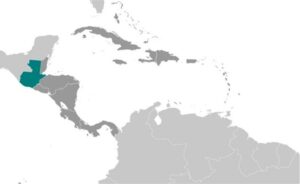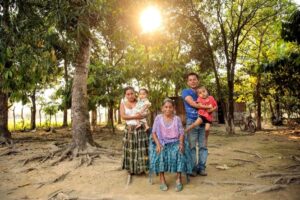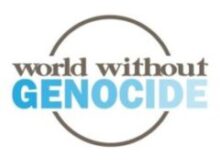Ecocide and Femicide in Guatemala: Paper Laws Afford No Protection

Guatemala is located in Central America.
This essay explores the link between ecocide, the destruction of the environment, and femicide, the intentional killing of women and girls, in Guatemala. In mass atrocities, there is almost always a direct link between ecological challenges and the resulting harm to people in the area, especially to women. This paper examines ways in which ecocide results in femicide, first by examining ways in which civil society normalizes and minimizes violence against women, allowing crimes against them to occur with impunity, and second, by understanding how “‘man camp’ environments that emerge around resource extraction projects”[1] decimate the environment and produce increased violence against women. Third, this paper explores how the Guatemalan government addresses crimes against the environment and women and the resulting widespread impunity for perpetrators. Finally, this paper examines how non-governmental organizations (NGOs) that work with the government can help strengthen the legislative infrastructure to include protections for the environment and for women in Guatemala by providing funding and training to implement laws effectively.
Civil Society’s Acceptance of Violence Against Women
The term ‘femicide’ and the rate of deadly violence against women are consistently overlooked by many sectors of civil society. In the US, violence against women is generally considered as an issue impacting low-income communities, particularly communities of color, and people in other, usually poorer, countries. Yet in 2021, the US ranked 34th highest in the world “for intentional female homicides at a rate of 2.6 killings per 100,000 women,”[2] or roughly three women a day.
The rate of killings in Guatemala in 2021 was three times higher than in the US, at 6.1 deaths per 100,000 women.[3] The United States Agency for International Development (USAID) found in 2022 that the number one reported crime in Guatemala was violence against women, “with 52,447 complaints filed,”[4] including 532 femicides.[5] Local government resolved only 20% of complaints and resolved even fewer femicide cases. USAID identified “gender inequality, and the violent, harmful, and controlling aspects of masculinities which are the result of patriarchal power imbalances”[6] as the root cause for widespread violence against women. When working in highly patriarchal countries like Guatemala, organizations like Amnesty International have found that government inaction results in impunity for perpetrators,[7] “especially when their victims are women.” The women of Guatemala have been disappeared, raped, and murdered by civilian men and by “members of the Guatemalan military and members of the Civil Defense Patrols.”[8] Women who speak to journalists withhold their names for fear of violence to them or their families. These factors intersect to create a public that tolerates women’s’ victimization and expects them to grieve in silence. This, combined with unenforced local laws, creates barriers for women to obtain justice and includes impunity for perpetrators.
The Man Camp, Femicide, and Ecocide
A ‘man camp’ is temporary housing established near construction, mining, or other work sites.[9] Establishment of man camps often brings violence to an area. Over 40% (6.5 million) of the population of Guatemala are members of 22 Mayan or other Indigenous groups.[10] Due to the high indigenous population, Guatemala was once considered “the most dangerous place for women in all of Latin America.”[11] Guatemala is rich in natural resources such as gold, silver, nickel, and titanium. Man camps established near resource extraction sites increases violence in the area. When combined with existing attitudes towards women and local government’s lack of protection for women’s rights, femicide occurs with impunity.

Guatemala is rich in natural resources.
Ecocide also occurs with impunity in Guatemala. In 2015, the palm oil company Reforestadora de Palmas AC (RESPA) poisoned 150 kilometers of the Río La Pasión (Pasion River).[12] Thousands of fish died and began to rot, further polluting the local community’s source of food, water, and livelihood. A case against RESPA was brought forward in Guatemala’s Environmental Crimes Court, and little has been done since to prevent similar incidents.
The Marlin Mine, a Canadian operation in Guatemala, has devastated local communities and the environment since 2005.[13] A study found that “the company’s presence introduced and/or exacerbated oppressive forces of dispossession, gendered marginalization, poverty, and a genocidal legacy.”[14] The large influx of male workers into the mining region results in “increased levels of precarious sex work, intimate partner violence, sexually transmitted illnesses, and gendered discrimination as social relations are restructured to cater to predominantly male consumers.”[15] This catering to man-camp consumers makes local women easy targets because the community discourages them from complaining for fear of losing business. Female victims rely solely on outsiders to bring attention to the threats and perpetration of gendered violence in mine operation areas. Researchers who study violence against women r have found, when interviewing members of these communities, “acknowledging victimhood became the focus as the interview became a relational process of sharing, being believed, and being supported.”[16] This supports the International Criminal Court’s stance that survivors “hunger for justice.”[17]
In addition, efforts of local women to prevent ecological damage in regions where the palm oil industry is present have “subjected [them] to violent attacks”[18] for their activism. The U.S. Department of State [19] and organizations like Human Rights Watch continue to raise concerns about violations of human rights and environmental damage in Guatemala. These concerns cover a wide range of areas including violence against women.[20]
Impunity for Femicide and Ecocide Perpetrators
For over forty years, Guatemala has enacted laws for the protection of women, and for over forty years, those laws have failed. In 1982, Guatemala ratified the 1982 Convention on the Elimination of All Forms of Discrimination Against Women (CEDAW). Guatemala ratified additional international conventions, including:
- The Convention Against Torture and Other Cruel, Inhuman, or Degrading Treatment or Punishment (1990),
- The International Covenant on Civil and Political Rights (1992), and the
- Optional Protocol to the Convention on the Elimination of All Forms of Discrimination Against Women (2002).
In 2012, “Guatemala made five voluntary pledges and commitments,”[21] including redesigning its human rights system and strengthening a justice system specializing in protection of women.[22] They passed a domestic law in 2008 criminalizing murder motivated by gender and imposing mandatory sentences for perpetrators without the option for allow for early release.[23]
Perpetrators in Guatemala have acted with impunity since the beginning of La Violencia, a 36-year civil war.[24] As men accused of being perpetrators returned to their homes at the end of La Violencia in 1996, the training they received, which included “rape, mutilation, torture, and femicide,”[25] continued to be used against the women in their homes and communities, and impunity granted during the war continued.[26] Despite the current perception of protection for women at a legislative level, there has been little change in the violence experienced by Guatemalan women since establishment of this legal framework. in fact, since implementation of the 2008 laws against femicide, there has actually been an increase in the number of women killed annually. Between 2008 and 2017, “over 7,273 acts of femicide”[27] were reported, doubling the number of incidents in the eight prior years.
Ecological justice faces similar issues in Guatemala. Guatemala established the Environmental Crimes Court in 2015, which is supported by a range of civil society leaders.[28] In its inaugural case, the court made an unprecedented decision by ruling that REPSA was responsible for the Río La Pasión “ecocide” and ordering REPSA to suspend operations.[29] The company was able to have the decision overturned and resumed operations. Nine years after the original decision against the palm oil giant, thousands of the indigenous people of Guatemala continue to be displaced to make space for the palm oil plantations.[30] Mining companies like REPSA continue to harm local communities and decimate the environment with impunity.
NGOs and Strengthening the Legislative Infrastructure

Maria Ba Caal (center) of Sepur Zarco fought for justice with 14 other survivors in Guatemala’s highest court, 2016. Image courtesy of UN Women/Ryan Brown is unmodified and licensed under CC BY-NC-ND 2.0.
Asocianción Generando Equidad Liderazgo y Oportunidades (ASOGEN), an NGO based in Chimaltenango, helps survivors seek justice and provides free medical, legal, social, and psychological support.[31] In a country where only “30 percent of femicide cases have led to sentencing,”[32] the cases pursued by ASOGEN’s legal team have a 95% rate of conviction.[33] Other NGOs are working to build systematic protections for the environment in Guatemala.[34] Asociación de Comunidades Forestales de Petén (ACOFOP) works with local communities to develop forest management techniques to reduce deforestation in the Mayan biosphere.[35]
To address the high rate of femicide, Guatemala’s government must establish collaborative relationships with NGOs. Collaborative efforts could be leveraged to reduce the possibility of future environmental harm resulting from government-sponsored and licensed activities such as mining and palm oil production. Man camp industries’ impact on the local communities, including the increase of violence towards women and girls, must be monitored. The government must hold companies liable for harm and must implement safeguards against future damage. Additionally, by working with NGOs, the government must establish funding for integral services, monitoring and reporting mechanisms, emergency response services, and legal resources for prosecutions and other legal protections.
This page was written by Jessica Arleen Tanem, Mitchell Hamline School of Law, spring 2024.
References
[1] Indigenous women speak out at Cop26 rally: Femicide is linked to ecocide, Libby Brooks, Nov. 10, 2021, available at https://www.theguardian.com/environment/2021/nov/10/indigenous-women-speak-out-at-cop26-rally-femicide-is-linked-to-ecocide.
[2] The Silent Epidemic of Femicide in the United States, Sanctuary for Families, Mar. 10, 2023, available at https://sanctuaryforfamilies.org/femicide-epidemic/.
[3] Intentional homicides, female (per 100,000 female) – Guatemala, The World Bank, 2024, available at https://data.worldbank.org/indicator/VC.IHR.PSRC.FE.P5?end=2021&locations=GT&most_recent_value_desc=true&start=2021&view=bar.
[4] Gender Based Violence, United States Agency for International Development, Jan. 2023, available at https://www.usaid.gov/guatemala/gender-based-violence.
[5] Gender Based Violence, United States Agency for International Development, Jan. 2023, available at https://www.usaid.gov/guatemala/gender-based-violence.
[6] Gender Based Violence, United States Agency for International Development, Jan. 2023, available at https://www.usaid.gov/guatemala/gender-based-violence.
[7] Why Does Guatemala Have One of the Highest Rates of Femicide in the World?, Amnesty International, 2024, available at https://www.amnestyusa.org/updates/why-does-guatemala-have-one-of-the-highest-rates-of-femicide-in-the-world/.
[8] Guatemala, No protection, no justice: killings of women in Guatemala, Amnesty International, Jun. 2005, available at https://www.amnesty.org/en/wp-content/uploads/2021/08/amr340172005en.pdf, 5.
[9] What Exactly is a “Man Camp”?, Arnold & Itkin Trial Lawyers, 2024, available at https://www.arnolditkin.com/blog/oilfield-accidents/what-exactly-is-a-man-camp-/.
[10] What Exactly is a “Man Camp”?, Arnold & Itkin Trial Lawyers, 2024, available at https://www.arnolditkin.com/blog/oilfield-accidents/what-exactly-is-a-man-camp-/.
[11] What Exactly is a “Man Camp”?, Arnold & Itkin Trial Lawyers, 2024, available at https://www.arnolditkin.com/blog/oilfield-accidents/what-exactly-is-a-man-camp-/.
[12] Ecocide and modern slavery in the land of the Maya: the impact of oi pal cultivation in Guatemala, Nazaret Castro, Equal Times, Sept. 26, 2017, available at https://www.equaltimes.org/ecocide-and-modern-slavery-in-the.
[13] Goldcorp’s Marlin mine: a decade of operations and controversy in Guatemala, Hayley Woodin, The Northern Miner Group, May 3, 2015, available at https://www.mining.com/web/goldcorps-marlin-mine-a-decade-of-operations-and-controversy-in-guatemala/.
[14] Gold mining on Mayan-Mam territory: Social unravelling, discord and distress in the Western highlands of Guatemala, C. Susana Caxaj, et. al., Social Science & Medicine, pages 50-57, Jun. 2014, vol. 111, available at https://www.sciencedirect.com/science/article/pii/S0277953614002159, 51.
[15] Gold mining on Mayan-Mam territory: Social unravelling, discord and distress in the Western highlands of Guatemala, C. Susana Caxaj, et. al., Social Science & Medicine, pages 50-57, Jun. 2014, vol. 111, available at https://www.sciencedirect.com/science/article/pii/S0277953614002159, 51.
[16] Tensions in anti-colonial research: lessons learned by collaborating with a mining-affected indigenous community, C. Susana Caxaj, et. al., Canadian Journal of Nursing Research, pages 76-95, Dec. 2012, vol. 44, issue 4, 85.
[17] Office of the Prosecutor Policy on Gender-Based Crimes, Crimes involving sexual, reproductive and other gender-based violence, Dec. 2023, International Criminal Court, 3.
[18] A matrix of violences: the political economy of violences against Mayan women in Guatemala’s Northern Transversal Strip, Julie Hartviksen, International Feminist Journal of Politics, pages 87-110, Oct. 05, 2021, vol. 24, issue 1, available at https://www.tandfonline.com/doi/epdf/10.1080/14616742.2021.1976066, 100.
[19] 2022 Country Reports on Human Rights Practices: Guatemala, Bureau of Democracy, Human Rights and Labor, United States Department of State, 2022, available at https://www.state.gov/reports/2022-country-reports-on-human-rights-practices/guatemala, 1.
[20] Guatemala Events of 2021, Human Rights Watch, 2022, available at https://www.hrw.org/world-report/2022/country-chapters/guatemala.
[21] GUATEMALA: Violence Against Women, The Advocates for Human Rights, Nov. 2017, The Advocates for Human Rights, available at www.theadvocatesforhumanrights.org/Res/guatemala_violence_against_women-march_2017.pdf, 2.
[22] GUATEMALA: Violence Against Women, The Advocates for Human Rights, Nov. 2017, The Advocates for Human Rights, available at www.theadvocatesforhumanrights.org/Res/guatemala_violence_against_women-march_2017.pdf, 3.
[23] GUATEMALA: Violence Against Women, The Advocates for Human Rights, Nov. 2017, The Advocates for Human Rights, available at www.theadvocatesforhumanrights.org/Res/guatemala_violence_against_women-march_2017.pdf, 3.
[24] Criminalization Is Not the Only Way: Guatemala’s Law against Femicide and Other Forms of Violence against Women and the Rates of Femicide in Guatemala, Sydney Bay, Washington International Law Journal, pp. 369-[v], Mar. 2021, vol. 30, no. 2, 374.
[25] Criminalization Is Not the Only Way: Guatemala’s Law against Femicide and Other Forms of Violence against Women and the Rates of Femicide in Guatemala, Sydney Bay, Washington International Law Journal, pp. 369-[v], Mar. 2021, vol. 30, no. 2, 374.
[26] Criminalization Is Not the Only Way: Guatemala’s Law against Femicide and Other Forms of Violence against Women and the Rates of Femicide in Guatemala, Sydney Bay, Washington International Law Journal, pp. 369-[v], Mar. 2021, vol. 30, no. 2, 374.
[27] Criminalization Is Not the Only Way: Guatemala’s Law against Femicide and Other Forms of Violence against Women and the Rates of Femicide in Guatemala, Sydney Bay, Washington International Law Journal, pp. 369-[v], Mar. 2021, vol. 30, no. 2, 384.
[28] A New Court in Guatemala Tackles Ecocide, Alana Marsili, United States Agency for International Development, Nov. 2015, available at https://2017-2020.usaid.gov/news-information/frontlines/resilience-2015/new-court-guatemala-tackles-ecocide.
[29] Three Years Since the Ecocide in the Río Pasión, Guatemala, Communities Still Struggle for Justice, Jeff Conant, Friends of the Earth, 2018, available at available at https://foe.org/blog/three-years-since-ecocide-rio-pasion-guatemala-communities-still-struggle-justice/.
[30] Palm oil giants push out smallholders in Guatemala; deforestation risks remain, Shanna Hanbury, Jan. 8, 2024, Mongabay, available at https://news.mongabay.com/2024/01/palm-oil-giants-push-out-smallholders-in-guatemala-deforestation-risks-remain/.
[31] ASOGEN Generando, 2024, available at https://asogen.org/quehacemos.php.
[32] Criminalization Is Not the Only Way: Guatemala’s Law against Femicide and Other Forms of Violence against Women and the Rates of Femicide in Guatemala, Sydney Bay, Washington International Law Journal, pp. 369-[v], Mar. 2021, vol. 30, no. 2, 388.
[33] Asocianción Generando Equidad Liderazgo y Oportunidades (ASOGEN), Frontline Women’s Fund Sisterhood is Global Institute, available at https://frontlinewomensfund.org/asogen/.
[34] Guatemala National Organizations, Global Climate Pledge, 2024, available at https://www.globalclimatepledge.com/global/guatemala/.
[35] Guatemala National Organizations, Global Climate Pledge, 2024, available at https://www.globalclimatepledge.com/global/guatemala/.


